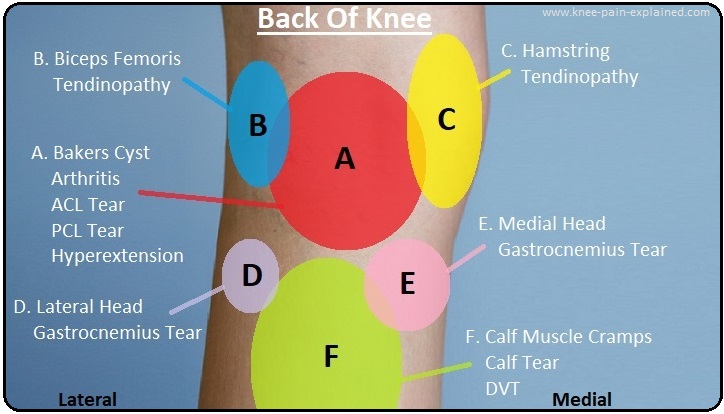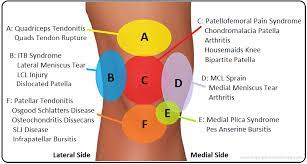Knee pain is one of the most common orthopedic complaints that people experience. It can range from a mild discomfort to severe pain, and it can be caused by a variety of factors such as injury, arthritis, or overuse. Identifying the location of your knee pain is crucial for proper diagnosis and treatment. A knee pain location chart can help you pinpoint where exactly your pain is coming from.
In this article, we will discuss the different types of knee pain and their corresponding locations on a knee pain location chart. By understanding where your knee pain is located, you can better communicate with your healthcare provider about your symptoms and receive appropriate treatment.
Knee Anatomy
The knee is a complex joint that plays an essential role in locomotion and provides stability to the lower extremities. It is the largest joint in the body and comprises three bones: the femur, tibia, and patella. The femur and tibia articulate with each other, while the patella acts as a shield for the front surface of the knee joint.
Knee pain can be caused by various factors such as injuries, overuse, or medical conditions like arthritis. To help diagnose what might be causing knee pain, healthcare professionals use a knee pain location chart. A knee pain location chart is a diagram that shows where on your knee you are experiencing pain and helps doctors determine which structures may be affected. Understanding your symptoms’ exact location can help doctors identify specific problems such as meniscus tears or ligament damage so they can recommend effective treatment.
Knee Pain Location Chart: Displaying Chart With Various Knee Pain Locations
Knee pain can be a debilitating condition that affects people of all ages. It is often caused by overuse, injury, or degeneration of the knee joint. Pain in the knee can occur in various locations, including the front, back, and sides of the knee. To help identify where your pain may be coming from, it is important to understand the different areas of the knee that are prone to injury.

One useful tool for identifying knee pain locations is a knee pain location chart. This chart displays various regions of the knee where pain may occur and helps individuals pinpoint where their discomfort is coming from. By using this chart as a reference guide, individuals can better understand what may be causing their knee pain and develop an appropriate treatment plan.
The knees are complex joints that support much of our body weight when we walk or run.
Causes Of Knee Pain: Listing Common Reasons For Knee Pain Based On Location
Premier Pain Centers is a leading medical institution that specializes in the diagnosis and treatment of knee pain. Knee pain is one of the most common musculoskeletal problems affecting people of all ages. The causes of knee pain are diverse, with different factors contributing to the onset and severity of symptoms.
One common cause of knee pain is osteoarthritis, which affects the cartilage lining in the joint and leads to inflammation, stiffness, and limited range of motion. Another frequent cause is patellofemoral syndrome, which results from abnormal tracking between the kneecap (patella) and thigh bone (femur), causing discomfort during activities such as walking or climbing stairs. Other causes include ligament sprains or tears, meniscus injuries, tendinitis, bursitis, fractures or dislocations.
Treatment Options: Mentioning treatment options for different types of knee pain
Knee pain can be a real hindrance, and it’s essential to understand the different types of knee pain and their treatment options. Knee pain can occur in various locations, such as the front, back or sides of the knee. By using a knee pain location chart, you can determine where exactly your pain is originating from.
For instance, if you’re experiencing anterior (front) knee pain that worsens when going up or downstairs, it could be patellofemoral syndrome. This type of knee pain often responds well to physical therapy exercises that build quadriceps muscles. On the other hand, if you have posterior (back) knee pain accompanied by swelling and stiffness, it might indicate osteoarthritis or Baker’s cysts. Treatment options for these conditions may include anti-inflammatory medications and joint injections.
Conclusion
Knee pain is one of the most common complaints among people of all ages. This type of pain can be caused by several factors including arthritis, injury, and overuse. It’s crucial to identify the location of knee pain to ensure effective treatment. Premier Pain Centers is a renowned center that provides comprehensive diagnosis and treatment for knee pain.
Firstly, identifying the location of knee pain can help healthcare professionals determine the underlying cause of the problem. For instance, if your knee hurts on the outer side, it could indicate an issue with your iliotibial (IT) band. But if you’re experiencing inner knee discomfort, then it might be related to a ligament tear or sprain. By identifying the exact location and severity of your symptoms, our experienced pain physician doctors at Premier Pain Centers will be able to create a personalized plan that works best for you.




